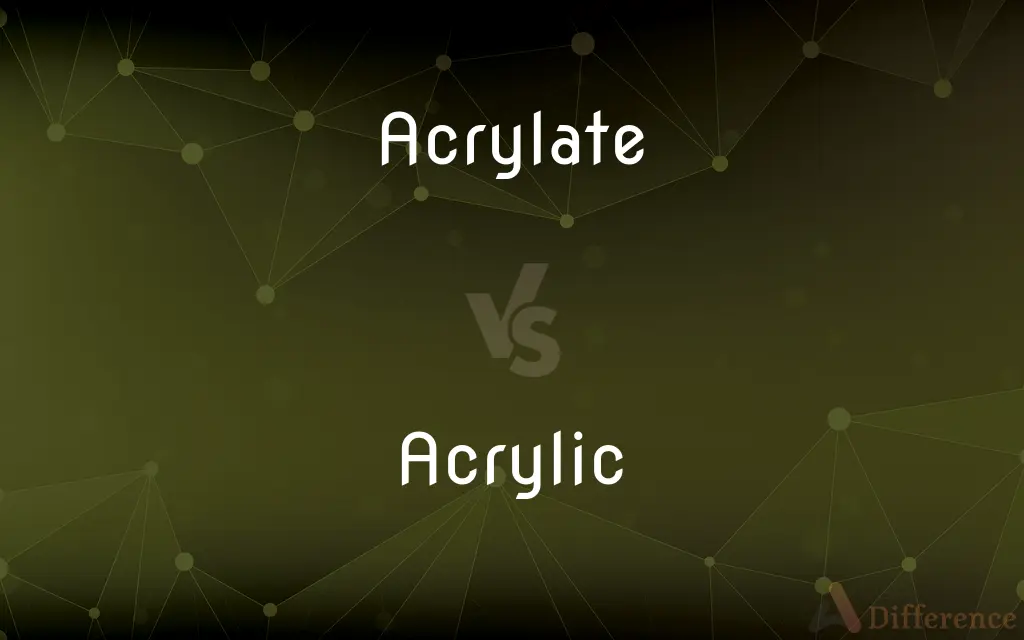Acrylate vs. Acrylic — What's the Difference?
By Urooj Arif & Maham Liaqat — Updated on March 7, 2024
Acrylate is a salt or ester of acrylic acid, used in polymers and plastics, while acrylic refers to synthetic materials derived from acrylic acid, notably in paints and fibers.

Difference Between Acrylate and Acrylic
Table of Contents
ADVERTISEMENT
Key Differences
Acrylate compounds are derivatives of acrylic acid, characterized by their use in manufacturing adhesives, coatings, and sealants. Whereas acrylic materials, such as acrylic fibers and paints, are well-known for their durability, lightweight, and resistance to weathering and chemicals.
Acrylates form when acrylic acid reacts with alcohols, resulting in a variety of products with specific properties tailored for industrial and consumer applications. On the other hand, acrylic products, such as PMMA (polymethyl methacrylate), often referred to as "acrylic glass," offer clarity and are used in applications ranging from optical devices to aquariums.
In the context of art supplies, acrylates are integral in producing acrylic emulsions that serve as binders for acrylic paints, enhancing their adhesion and durability on various surfaces. Meanwhile, acrylic paints themselves are prized for their fast-drying properties, versatility, and vibrant colors, largely attributable to the acrylic polymers they contain.
In the medical field, acrylate polymers are utilized in drug delivery systems and medical adhesives, leveraging their biocompatibility and customizable properties. Conversely, acrylic is used in the manufacture of prosthetics and dental devices, benefiting from its strength and aesthetic qualities.
In textiles, acrylates are often used as finishing agents to enhance fabric properties, such as water resistance and stain repellence. Acrylic fibers, however, are synthetic fibers made from a polymer (polyacrylonitrile) with at least 85% acrylonitrile monomers, offering warmth and lightweight alternatives to wool.
ADVERTISEMENT
Comparison Chart
Definition
Salt or ester of acrylic acid
Synthetic materials derived from acrylic acid
Applications
Adhesives, coatings, sealants
Paints, fibers, and plastics
Chemical Composition
Acrylic acid + alcohol
Polymers of acrylic acid or acrylonitrile
Key Properties
Customizable for specific applications
Durability, lightweight, weather and chemical resistance
Example Uses
Industrial adhesives, paint formulations
Acrylic paints, acrylic fibers, PMMA
Compare with Definitions
Acrylate
A key ingredient in photoresist materials for semiconductor manufacturing.
Acrylate polymers are essential for developing intricate circuit patterns.
Acrylic
A type of synthetic polymer used in textiles and plastics.
Acrylic fibers are popular in sweaters for their lightweight warmth.
Acrylate
Used in dental materials for its bonding properties.
Dental adhesives contain acrylates for secure fillings.
Acrylic
Material for lightweight and impact-resistant eyeglass lenses.
Acrylic lenses offer an alternative to glass with fewer breakage risks.
Acrylate
Common in coatings for its adhesive qualities.
Acrylate coatings protect metals from corrosion.
Acrylic
A clear plastic known as PMMA or acrylic glass.
Acrylic sheets are used for shatter-resistant windows.
Acrylate
A salt or ester formed from acrylic acid.
Methyl methacrylate is used in making acrylic glass.
Acrylic
Used in nail enhancements for its durability.
Acrylic nails are favored for their long-lasting finish.
Acrylate
Integral in making soft contact lenses for comfort and oxygen permeability.
Silicone acrylates are used for their flexibility and breathability in contact lenses.
Acrylic
Paint made with acrylic resin offering quick drying times.
Artists prefer acrylic paint for its versatility and fast drying.
Acrylate
Acrylates (IUPAC: prop-2-enoates) are the salts, esters, and conjugate bases of acrylic acid. The acrylate ion is the anion CH2=CHCOO−.
Acrylic
(of synthetic resins and textile fibres) made from polymers of acrylic acid or acrylates
A red acrylic jumper
Acrylate
(organic compound) Any salt or ester of acrylic acid.
Acrylic
An acrylic textile fibre
A sweater in four-ply acrylic
Acrylate
A salt or ester of propenoic acid
Acrylic
An acrylic paint
Washes of white acrylic
She paints mainly in acrylics
Acrylic
An acrylic resin.
Acrylic
A paint containing acrylic resin.
Acrylic
A painting done in acrylic resin.
Acrylic
Any of numerous synthetic fibers polymerized from acrylonitrile.
Acrylic
(organic chemistry) Derived from acrylic acid or acrylonitrile.
Acrylic
Containing an acrylic resin.
Acrylic
(organic chemistry) An acrylic resin.
Acrylic
(painting) A paint containing an acrylic resin.
When it comes to painting, I prefer using acrylics as my medium.
Acrylic
A painting executed using such a paint.
Acrylic
A thick sheet of plastic.
Acrylic
A liquid coating system based on an acrylic resin.
Acrylic
Of or containing acryl, the hypothetical radical of which acrolein is the hydride; as, acrylic acid. The characteristic residue in an acrylic compound is the carbonyl group attached directly to an ethylenic carbon.
Acrylic
Same as acrylic resin.
Acrylic
Same as acrylic fiber.
Acrylic
A paint in which the pigment is suspended in a solution of an acrylic resin, which dries to a hard film on exposure to air.
Acrylic
A painting made using an acrylic paint.
Acrylic
Polymerized from acrylonitrile
Acrylic
A glassy thermoplastic; can be cast and molded or used in coatings and adhesives
Acrylic
Used especially by artists
Acrylic
A synthetic fabric
Common Curiosities
What is acrylate used for?
Acrylate is used in making adhesives, coatings, and sealants.
What makes acrylic fibers unique?
Acrylic fibers are known for their warmth, lightweight, and resistance to sunlight and chemicals.
Is PMMA the same as acrylic?
Yes, PMMA (polymethyl methacrylate) is a type of acrylic plastic, often referred to as acrylic glass.
How are acrylates used in textiles?
Acrylates are used as finishing agents to improve fabric properties like water resistance and stain repellence.
What role do acrylates play in cosmetics?
Acrylates are used in cosmetics for their adhesive properties and ability to form films, contributing to long-wearing makeup.
Are there health concerns associated with acrylates?
Some individuals may experience sensitivities or allergies to acrylates, particularly in cosmetic or medical applications.
How is acrylic different from acrylate?
Acrylic refers to synthetic materials derived from acrylate compounds, including plastics and fibers, whereas acrylate is specifically a salt or ester of acrylic acid.
Can acrylate be used in medical applications?
Yes, acrylate polymers are used in drug delivery systems and medical adhesives.
Are acrylic materials environmentally friendly?
While acrylic materials are durable and versatile, their environmental impact depends on their production, use, and disposal practices.
How do acrylates contribute to automotive manufacturing?
Acrylates are used in automotive paints, sealants, and adhesives for durability and aesthetic quality.
How are acrylic and acrylate polymers synthesized?
Acrylic polymers are synthesized through the polymerization of acrylate monomers, forming long chains that determine the material's properties.
What are the advantages of acrylic paints?
Acrylic paints dry quickly, are water-soluble, and offer vibrant colors with excellent durability.
Can acrylates be found in everyday products?
Yes, acrylates are found in a wide range of products, including paints, adhesives, and cosmetics.
Can acrylic be recycled?
Acrylic can be recycled, though the process and facilities available vary by location.
Why are acrylic materials popular in construction?
Their strength, lightweight, and resistance to impact and weathering make them ideal for various construction applications.
Share Your Discovery

Previous Comparison
Distinct vs. Unique
Next Comparison
Esquire vs. SquireAuthor Spotlight
Written by
Urooj ArifUrooj is a skilled content writer at Ask Difference, known for her exceptional ability to simplify complex topics into engaging and informative content. With a passion for research and a flair for clear, concise writing, she consistently delivers articles that resonate with our diverse audience.
Co-written by
Maham Liaqat













































